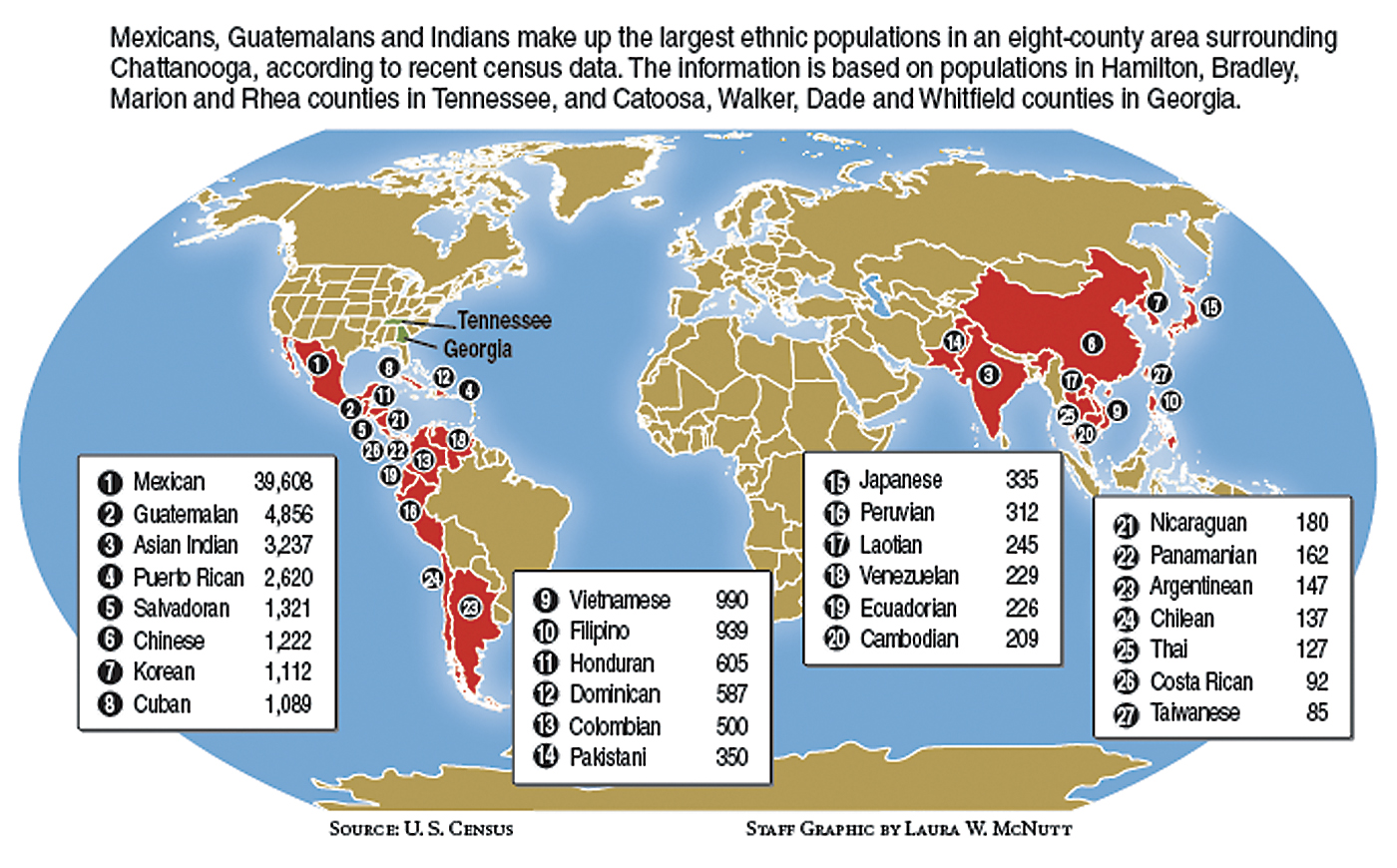Chinese immigrant Michael Zhou came to Chattanooga for a job at BlueCross BlueShield of Tennessee in 1998, and now can't imagine living anywhere else.
"I like the small-town setting, it's not that crowded, it's also relatively safe," said Zhou, who now works at Unum.
New U.S. census figures released Thursday indicate he's not alone.
Minority groups in Chattanooga - from Chinese to Argentinians to Puerto Ricans - grew at much faster rates than the overall population from 2000 to 2010. The foreign-born make up a small yet increasing part of the region.
Census paperwork allows immigrants in the U.S. to check the names of 18 Asian nationalities and 19 Spanish-speaking countries. An eight-county area including Hamilton, Bradley, Catoosa, Dade, Marion, Rhea, Walker and Whitfield had respondents from all 27 countries except Bhutan, a small, mountainous state between India and China.
The number of Hondurans, Guatemalans and Salvadorans all increased by more than 300 percent over the decade in the eight-county Chattanooga area. Among Asian groups, Filipinos and Chinese showed the most growth, increasing by 80 and 67 percent respectively. The Chinese population overtook Koreans to become the second-biggest Asian group in the region behind Indians.
Other Asian populations, such as Vietnamese, Koreans and Japanese, grew more slowly than Chinese, at about 30 percent.
Overall, the Indian subset grew by 67 percent and remained the largest local group with 9,500 respondents.
Doug Bachtel, a demographics expert with the University of Georgia, said minority growth in the Southeast has to do primarily with higher-than-average birth rates among minorities and an influx of immigrants. People from Honduras, Guatemala and El Salvador come to the tri-state area for the same reasons as other immigrants, he said.
"Similar to the Mexican folks, they'll be here for the job opportunities," he said.
Mexicans make up 70 percent of Latino residents in the area, but that number is down from 73 percent in 2000. The Mexican population grew by 96 percent during the last decade to nearly 40,000, but that was a few ticks below the 104 percent growth in the overall Hispanic population.
In addition to jobs, some Hispanic immigrants are attracted to the region by family and friends.
"They want to be around family and support each other," said Jessica Cliche, a Guatemala native who moved to the United States 11 years ago. Cliche is with La Paz, a Chattanooga nonprofit that works with the Hispanic community.
She said most Guatemalans she works with are coming here from other states, including Alabama, Georgia and Mississippi.
The growing Chinese population is less easily explained, Bachtel said. He guessed many of the Chinese were attending area universities, but said the growth is tougher to pinpoint.
"There must be something that is bringing that Chinese population to Chattanooga," he said.
Zhou said he can see the growth by looking at local shopping centers. The number of stores and restaurants that cater to different ethnic communities is a clear indication that Asian groups, including Chinese, are becoming a larger presence in the area, he said.
"We have much more choices now," he said.
Though the census numbers show big percentage increases across the board, groups that work with the immigrant communities, said the numbers seem a lot lower than the actual populations.
According to the census, there were about 3,000 Guatemalans - the fastest-growing Hispanic group - in Hamilton County and fewer than 200 in Bradley County.
"When you get the census numbers, you multiply that by three or five," said Frances Irizarry, director of ethnic ministries at the Bradley Baptist Association. "I know several people who got the census forms and threw them away. They didn't know what it was about."
Irizarry noted that immigrant populations "also have high mobility."
"People move around so much, half of my contact list is unusable," added Irizarry, a board member and volunteer of the Mosaic/Ocoee Regional Multicultural Services, a nonprofit in Cleveland, Tenn., that promotes cultural diversity.
Another challenge in getting immigrant communities to participate in the census is the high illiteracy rate, said both Irizarry and Cliche.
"My theory is that some of them don't know how to read or write and I don't think they understand why they have to fill out the census [form]," said Cliche.
In past questionnaires, the Census Bureau has asked for ethnic origin, including Europe and Africa. But a bureau spokeswoman said Wednesday that question was dropped when the survey went to the short 10-question form in 2010.
The national ethnicity question in 2010 was only asked of Asian or Hispanic respondents because the bureau considers a nationality such as Laotian or Colombian a race, the spokeswoman said.

